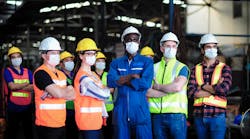One of the most common email questions I get from around the world is “How big should our maintenance department be?” What an unfair question! If the company built a pile of junk, it will need more persons than if the company built a plant with better equipment. I have no idea how much attention the company puts into installing reliable assets. Nevertheless, the current maintenance force at an ongoing plant, whatever its state of repair, is probably the right size already! That’s a surprising statement!
This article is part of our monthly Palmer's Planning Corner column. Read more from Doc Palmer.
At many ongoing plants, management has “sized” its current maintenance force over the years to be a somewhat profitable plant as evidenced by the fact that they are still in business. But management has fine-tuned the workforce size to a large degree in response to the operations group calling for maintenance. The louder and more frequently operators call, the easier it is to justify and hire more maintenance staff. Yet at times when operations is not particularly calling loudly, if maintenance persons retire or otherwise leave, management is not quick to replace them.
Management thinks, “We have eight electricians, but two are leaving. Let’s see if we can get by with six electricians because we seem to have everything under control right now.” And then later, when operations starts calling again (loudly and frequently), management will hire more electricians. Unfortunately, what these plants have done is actually sized their maintenance forces perfectly to take care of all the reactive maintenance as it happens.
Sized for reactive maintenance
This thinking is exactly backwards. We need maintenance people to keep operations from having to call in the first place! Maintenance is “keeping things from breaking,” not fixing them after they break! Maintenance means “to be maintaining,” not to be restoring. Deep in their hearts, the operations people know that something is wrong if they are continually calling the maintenance group to come fix things that are not working right. The operators would really like to have a plant to operate.
So the logical question is “How do we keep things from breaking?” Well, we can do more proactive maintenance to head off reactive maintenance. We can do more PMs to keep things properly tightened, lubricated, and clean. We can do more PM inspections to look for little problems before they affect operations. We can do more PdM driven work using technology such as vibration analysis, infrared, and ultrasound to find even smaller problems before anyone can otherwise find them. We can do more project work to replace inherently unreliable equipment. Unfortunately, therein lies the rub. We have sized our maintenance force exactly to the right size to handle all the reactive maintenance. We have our hands full of reactive maintenance. There is no extra labor capacity to do extra proactive work. But we must do more proactive work now at the same time we are reaping the reactive work from our past of not doing enough proactive work. There is no extra labor available.
Planning a fully loaded weekly schedule at your plant
Why a weekly schedule is the right timeframe for productivity
Implementing a priority system to create and maintain a profitable plant
Find a boost in labor productivity
This situation is perfect for planning and scheduling assistance. One of the main benefits of proper planning and scheduling is a boost in labor productivity. A plant completing 300 work orders per month could be completing 450 work orders per month, a 50% pop! How in the world is that possible? Everyone at the plant is already working as best they can.
Even so, statistical work sampling studies reveal that “wrench time” for most maintenance forces is only about 35%. Craftspersons available to work an entire shift are on the average moving jobs ahead only a third of the time. Yes, some of the other time is spent in breaks and check-in meetings (all necessary, but non-productive activities). But even more of the other time is spent on activities such as gathering parts and tools, traveling on the plant site, and even simply receiving assignments.
Proper planning and scheduling can boost the wrench time to upwards of 55%. Now even 55% does not seem like much, but consider that 55 divided by 35 equals 1.57. So the workforce gets a 57% boost in work order completion rate. And because we already have the reactive work covered, all the extra work, by definition, is proactive work. So planning and scheduling answers the question “How can we do more proactive work when our hands are full of reactive work?”
Of course, wrench time is not the ultimate measure. Carpenters could show up at the wrong job and hammer super slowly never taking a break. They would have 100% wrench time doing the wrong job inefficiently! Nevertheless, we presume that management assigns and supervises the work as best they can, and if more work is completed, then any extra work should be proactive.
Proactive work to head off future failures
“So how big should our maintenance department be?” On one hand, for many ongoing plants, the maintenance department is already perfectly sized to give decent enough profits to keep the plant in business by quickly fixing things as they break. On the other hand, with proper planning and scheduling, the currently sized maintenance department is also perfectly sized to give much greater profitability by handling all the current reactive work, plus doing a lot more proactive work to head off future failures. And as the reactive work declines, the workforce can do even more proactive work.
Don’t settle for being a decent plant. Lead your plant to greatness.
This story originally appeared in the June 2021 issue of Plant Services. Subscribe to Plant Services here.



